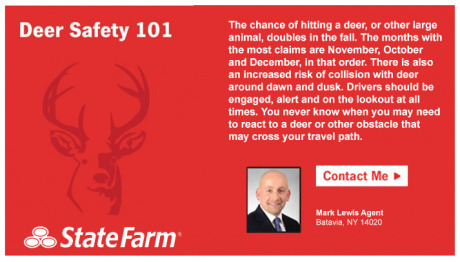INSURANCE
Sponsored Post: Winter driving tips - State Farm - Mark Lewis
Prepare Your Vehicle for Winter: The best time to get ready for winter is before the first storm of the season. Some items to check and talk to your mechanic about include:
- Test the battery strength.
- Inspect the exhaust system and the air, fuel, and emission filters.
- Check the cooling system, windshield wiper and antifreeze fluid levels, and change the oil.
- Make sure hoses and fan belts and all components are working properly.
- Consider changing the spark plugs.
- Check the tire pressure, tread life and consider installing winter tires.
- Locate the spare tire, jack, and ice scrapper.
- Inspect your wiper blades to make sure they're functional and in good condition.
Some Simple Winter Driving Tips: Winter driving has its own set of challenges from the moment you start your vehicle. Here are some useful winter driving suggestions:
- Never warm up your vehicle in a closed garage. This could lead to carbon monoxide problems.
- Keep your gas tank at least half full to prevent gas line freeze-up.
- Make sure your exhaust pipe is not clogged with mud or snow.
- Don't use cruise control on icy roads.
- Allow more time for braking when visibility is poor.
- Stay calm if you start to skid.
Commercial vehicle drivers should exhibit caution when driving in winter conditions. If your vehicle is large, like a truck, it needs more time to stop in ideal conditions, so snow and icy conditions magnify the challenge. Take care to continue safe practices when sharing the road in winter conditions.
Carry a Winter Driving Kit: Winter weather could leave you stuck in the snow, but the following items in your winter driving kit might help you get back on the road and on your way:
- Small folding shovel
- Tow and tire chains
- Basic tool kit
- Bag of road salt or cat litter
- Flares, battery powered flashlights and extra batteries
- Extra windshield wiper fluid and antifreeze
- Jumper cables to start your car if your battery dies
Pack a Winter Survival Kit: In case you're marooned in your car, truck or SUV, you might want to keep a small winter survival kit on hand. Some useful items include:
- A first-aid kit
- Cell phone charger
- Ice scraper and brush
- Blankets, warm clothing and other cold weather gear to protect against hypothermia
- Drinking water, and high-energy, nonperishable foods
Snow Safety Tips if You Become Stranded in the Winter: Few people like driving through a snow storm, and most heed warnings to stay off the roads when a storm is bearing down. But even the best-prepared and expert drivers can get stuck. If it happens to you, here are some important reminders:
Be prepared. While the best first step is prevention, some storms come on quickly. If you do get stranded, keeping a few essentials, noted above, in your car can help keep you comfortable while you wait.
Stay inside. If possible, pull off the highway and turn your hazard lights on or tie something bright to your car’s antenna to signal that you need help. Then wait inside your car until help arrives to avoid exposure to frostbite and prevent hypothermia.
Call 9-1-1. If you have a charged phone and reception, call for help and describe your location as best you can.
Clear the tailpipe. Make sure there’s no snow covering your tailpipe in order to prevent carbon monoxide buildup inside the car. Check the tailpipe periodically to ensure that fresh snow isn’t blocking it, always watching for oncoming traffic before exiting your vehicle.
Keep moving. Staying active inside your car will help you keep warm. Clap your hands and tap your toes to keep your circulation moving and prevent frostbite but avoid overexertion and sweating.
Drink fluids. Dehydration can make you more susceptible to the effects of cold. If there’s no drinking water inside your car, melt some snow inside a bag or other makeshift cup to stay hydrated.
Conserve your vehicle's battery. Use lights, heat, and radio sparingly.
Run your engine. Provided you have enough gas in your tank, run the engine for about 10 minutes every hour to keep the car warm. Turn on interior lights when your engine is on so you can be seen inside your car. Open a downwind window slightly for ventilation and clear snow from the exhaust pipe to prevent carbon monoxide poisoning.
Don’t overexert yourself. Cold weather puts your heart under added stress. If you’re not used to exercise, shoveling snow or pushing a car could put you at risk of a heart attack.
Stay safe and warm this winter by learning more about preparation for and recovery from winter storms with State Farm®
Sponsored Post: State Farm - Mark Lewis Agency - Get your home winter ready
Be energy efficient
Since your heating system will probably be running constantly throughout the winter, remember to change out your HVAC filters every month. Inspect the insulation in your attic and crawl space. Warm air rises and leaves the house through the roof, so you should focus on insulation in your ceilings. Seal areas around recessed lights, the attic hatch, and plumbing vents that may be allowing warm air from the living space below to enter the attic. Proper attic ventilation, adequate attic insulation, and a tight air barrier between the attic and the interior of the house will work together to prevent ice dams.
If you don't have double-paned windows, remove the screens and install storm windows to ensure that the heat stays in and the cold stays out. If you're on a tight budget, pick up an inexpensive plastic-film sheet kit from your local hardware store. These will only last one season, but they do help with energy efficiency and are able to halt the cold flow of winter drafts. If you have a fireplace, burning firewood is another way to save energy costs. When you use the fireplace, reduce heat loss by opening dampers in the bottom of the firebox (if provided) or open the nearest window slightly -- about an inch -- and close doors leading into the room. That will prevent the fire from drawing warm air out of the rest of the house and replacing it with cold air. And remember to store your firewood in a dry place at least 30 feet from your home to avoid a fire hazard.
Protect your pipes
Pipes located in attics, crawl spaces, basements, and near outer walls can be susceptible to freezing in extreme temperatures. When the forecast calls for unusually cold temperatures, let water drip from hot and cold faucets overnight. Also try keeping cabinet doors open to allow warm air to circulate in places like below sinks. If you open the cabinet doors, be sure to remove anything inside the cabinets that may pose a safety to hazard to children, such as household cleaners. For exposed pipes in your attic, basement or crawl spaces, add extra insulation around them. View the tips to avoid frozen pipes for more information.
Be ready for an emergency
Blackouts and snow-ins can occur during winter months, so take a moment to prepare yourself and your family for such emergencies. Having the following items ready will help you make it through safely.
- Flashlights
- Bottled water
- Nonperishable food items
- Blankets
- Phone numbers for your utility companies
- Battery backup to protect your computer and other important electronic equipment
- First-aid kit
Decorate safely
'Tis the season to be festive, but remember to stay safe with your holiday decorations. Inspect the wires of your light display before switching them on—they may be frayed and present an electrical fire hazard. Same goes for the Christmas tree inside -- always check the light strands for any sign of wear and tear from being in storage. If you have a real Christmas tree, keep it watered, since dry trees catch fire easier. Check with your local municipality for instructions on how to dispose of the tree once the new year arrives.
Don't forget yard care
Even with the cold weather conditions, your yard still needs to be maintained. Make sure tree and shrub branches are well away from the house and windows. Icy conditions can cause branches to break and damage your home. Walk around your home and survey the roof to see if any ice dams have formed; call a contractor if you suspect this is the case. As you walk around your house, check the foundation for small cracks or openings where mice or other pests can tunnel in. Winter is when they seek the warmth of your house, so seal up any possible entrances. While you're outside, clear snow off gas meters and away from basement windows and your dryer exhaust vent.
Sponsored Post: State Farm - Mark Lewis Agency offers Thanksgiving Food Safety Tips
Keep everything clean
- Scrub hands with soap under warm water for 20 seconds. Do the same after handling food, especially raw meat or poultry, to avoid cross-contamination.
- Clean counters, cutting boards, dishes and silverware with hot water and soap before and after preparing each food item.
- Wash fruits and vegetables to remove surface dirt, but do not rinse raw meat or poultry — this makes it more likely for bacteria to spread.
Heat food to proper temperature
- Color is never a reliable indicator of safely cooked food. Use a food thermometer to make sure meat, poultry, and fish are cooked to a safe internal temperature — typically 165 degrees.
- Frying your turkey? Follow our turkey fryer safety tips.
Keep foods at appropriate temperatures
- Keep hot foods at 140 degrees or warmer with chafing dishes, slow cookers and warming trays.
- Keep cold foods at 40 degrees or colder. Nest serving dishes in bowls of ice and store moist desserts, such as pumpkin pie and cakes with whipped frosting, in the refrigerator until serving.
- Never let food sit out at room temperature for more than two hours.
Store leftovers safely
- Divide leftovers into shallow containers, which allow rapid cooling, before storing in the refrigerator or freezer.
- Never defrost food at room temperature. Use a microwave or oven to reheat foods to an internal temperature of 165 degrees.
- Eat leftover food within three to four days.
Sponsored Post: State Farm - Mark Lewis Agency offers deer safety tips
No matter where you live, or what time of day you are driving, it’s important to remain alert. Keep your eyes up and focused on the road. This helps you take action in the event a deer is suddenly in your path. Other tips to help keep drivers safe include:
- Slow down, particularly at dusk and dawn;
- If you see one deer, be prepared for more deer to cross the road;
- Pay attention to deer crossing signs;
- Always buckle up — every trip, every time;
- Use your high beams to see farther, except when there is oncoming traffic;
- Brake if you can, but avoid swerving; this can result in a more severe crash;
- Remain focused on the road; scan for hazards, including animals;
- Avoid distractions; devices or eating might cause you to miss seeing an animal;
- Do not rely on products such as deer whistles; they are not proven effective;
- If riding a motorcycle, always wear protective gear; keep focus on the road ahead.
Mark Lewis Agency - State Farm, 8331 Lewiston Road, Batavia. Call today 585-343-4959 > Click here to visit us online <








